The Russian response to Obama
 Bashny.Net
Bashny.Net
Asymmetric response BELARUS AND RUSSIA PLANS TO WASHINGTON
From Moscow and Minsk almost simultaneously, with a difference of one day, we made a statement that Russia begins deliveries to Belarus newest tactical missile system (PTRC) "Iskander-E", and she begins to rearm an even more perfect "Iskander -M '. Both parties do not hide that the retrofitting to a large extent is the answer to deploying US missile defense (NMD) in Poland and the Czech Republic. So through its Spokesman Andrei Popov is the Belarusian Foreign Ministry made it clear: "Our republic will ensure its security in the new conditions, particularly in terms of placing elements of the US missile defense system in Europe." Especially since, according to him, Minsk sees no objective preconditions and reasons for placement in close proximity to the elements of the system of Belarus. And the chief of the Missile Forces and Artillery (PBA) of the Armed Forces (AF), Colonel-General Vladimir Zaritsky also stressed that the supply of Russian "Iskander" in Belarus can be considered as a variant of an asymmetric response to the deployment in Europe of US missile defense.
Analysts in both countries is still "obsmakovyvayut" the theme of "Iskander" for Belarus. It's no wonder, because the relationship between Minsk and Moscow because of the known problems in the price of gas and oil to Belarus in the past year and a half has cooled considerably. And then such a successful agreement in the military sphere! After almost Belarus was the first country, which will begin delivery of said missiles. Assumptions are also sometimes fantastic (if not tactful to say "crazy") character. For example, one of the notorious military observers agreed to the fact that Russia, delivering "Iskander-E", thus transit via Belarus wants to smuggle complexes to Syria. "MIC" tried, using only open sources, as they say, from different angles to analyze the situation.
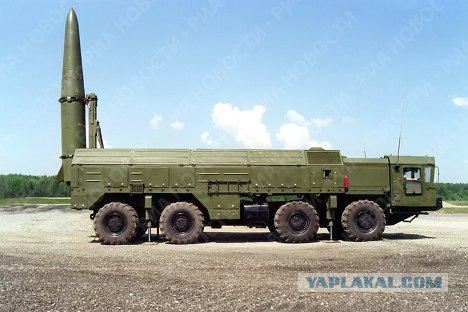
High-precision operational-tactical missile complex land forces 9K720 "Iskander" for the secretive preparation and application of effective missile strikes on especially important miniature and area targets in the depth of operational formation of the enemy: fire weapons (missiles, multiple rocket launcher systems, long-range artillery), aircraft and helicopters airfields, command posts and communications nodes, critical civilian infrastructure.
PTRC 9K720 created as a result of the joint work group of research institutes, design bureaus and factories under the leadership of Machine Building Design Bureau (KBM Kolomna), known as a company-maker of missile systems "Point", "Oka". The launcher is designed CDB "Titan" (Volgograd), homing system - the Central Research Institute of Automatics and Hydraulics (Moscow).
Under the conditions of the INF Treaty of 1987 and the non-use of nuclear weapons in the theater to modern tactical systems presented a number of new requirements:
* Use only non-nuclear weapons;
* Ensure precision shooting accuracy;
* Management throughout the flight path;
* Wide range of effective combat equipment;
* Availability of complex automation systems and command and control information management system, including the preparation of standard information systems for correction and final guidance;
* The possibility of interconnecting with the global satellite navigation systems (GNSS - "Glonass», «NAVSTAR»);
* The ability to defeat heavily defended purposes;
* Improving fire performance;
* The ability to effectively overcome the effects of air defense and missile defense;
* The possibility of destruction of moving targets.
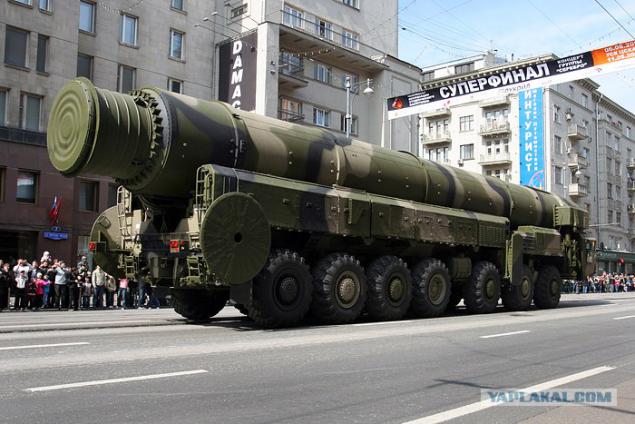
To meet the above requirements established export version PTRC 9K720, designated "Iskander-E". "Iskander-E" incorporates the best scientific, technical and design achievements in the field of tactical missiles and jointly implemented technical solutions, high combat effectiveness is an entirely new generation of weapons, superior to their tactical and technical characteristics of existing RC 9K72 "Elbrus", "Tochka-U», «Lance», «ATASMS», «Pluton», and others.
The main features of the Republic of Kazakhstan 9K720 «Iskander»:
* High-precision and effective engagement of various types of targets;
* The possibility of secretive preparation, alert and effective missile strikes;
* Automatic calculation and entry flight mission rocket launcher means;
* High probability of combat mission in the face of strong enemy opposition;
* High probability of trouble-free operation of a rocket in preparation for launch and in flight;
* High tactical maneuverability thanks to all-terrain military vehicles, mounted on four-wheel drive chassis,
* Strategic mobility due to transportability of machines all modes of transport, including transport aircraft;
* Automation of combat control missile units,
* Prompt processing and bring intelligence to the appropriate management levels;
* Long life and ease of use.

"Iskander-E" in their tactical and technical characteristics fully in line with the position of Control Regime non-proliferation of missile technology. This "weapon of deterrence" in local conflicts and in countries with limited living space - a strategic weapon. The structure of the complex, its management systems, automated command and control and information systems make it possible to respond quickly to new requirements without substantial revision of its combat vehicles and, therefore, guarantee a long life cycle.
For the Russian army developed version of the missile complex "Iskander" with extended range (400km), but also equipped with cruise missiles "ground-ground" of the "Caliber" (SKB "Innovator" Bratislava). The complex, designated "Iskander-M", successfully tested on May 29, 2007. on at Kapustin Yar.
In the west complex has received the designation SS-26.
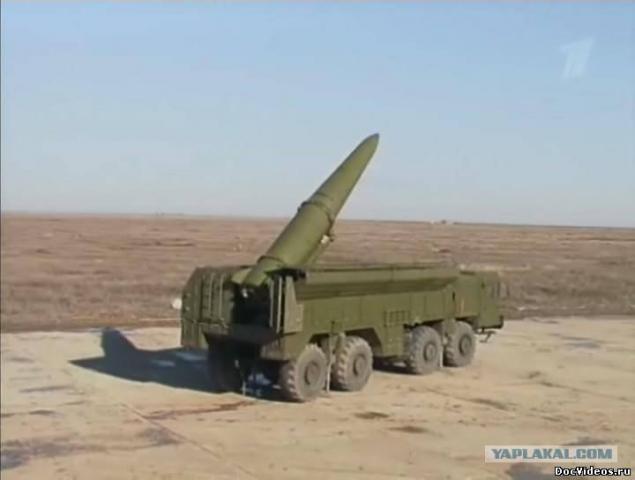
The complex includes:
* 9M723 missile;
* Self-propelled launcher 9P78 (SDA);
* Transport and loading vehicle 9T250 (TPM);
* Command-staff vehicle 9S552 (CSV);
* Movable item of information 9S920 preparation (PPI);
* Vehicle regulation and maintenance (MRTO);
* Life-support machine;
* Sets the arsenal and the training equipment.
Missile 9M723 - solid-fuel, single stage with a non-detachable warhead in flight. The missile is controlled throughout the flight path with the help of aerodynamic and gasdynamic rudders. The flight path is not 9M723 ballistic and controlled. The rocket plane is constantly changing trajectory. Particularly active in the area, she maneuvered her acceleration and approach to the goal - with an overload of 20 to 30g. In order to intercept a missile 9M723, antimissile should move along the path with the overload of two to three times higher, and it's almost impossible. Most of the trajectory the rocket, made by technology 'Stealth' and having a small reflecting surface is at an altitude of 50 km, which also significantly reduces the likelihood of its defeat the enemy. The effect of 'invisibility' is achieved through the combination of design features and handling of missiles with special coatings.
Directly on the target missile is displayed c using an inertial control system and then captured autonomous correlation-extreme optical homing head (see photo). The operating principle of homing OTP 9M723 is that the optical apparatus forms an image of the terrain in the target area, which is compared to an onboard computer with an introduction to the preparation of the rocket for launch benchmark. The optical head has a high resistance to existing electronic warfare and allows the successful launch even on moonless nights, when there is no more natural lighting purpose, striking a moving target with an accuracy of plus or minus two meters. A similar problem, except for "Iskander" can not solve none of the tactical system in the world. In addition, the optical system does not require signals from space navigation system, which is in crisis cases, it may be turned off or disabled by RFI. Integration of inertial control with satellite navigation and optical seeker to create a missile strikes a given target in almost any conceivable circumstances. Seeker can also be used in the ballistic and cruise missiles of various classes and types.
The missile can be fitted with different warheads (total of 10 types), incl .:
* Cassette warhead with fragmentation submunitions undermine the non-contact;
* Cassette warheads with cumulative fragmentation submunitions;
* Cassette warhead submunitions with self;
* Cassette warhead volume-detonating action;
* High-explosive fragmentation warhead (OFBCH);
* High-explosive incendiary warhead;
* Penetrating warhead (COEP).
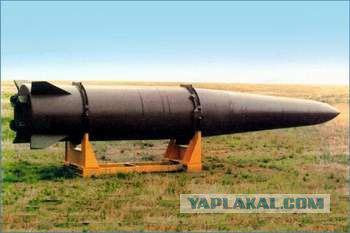
Cassette warhead ensure disclosure at the height 0.9-1.4km with further separation and stabilization of combat elements. Submunitions equipped with radio sensors, undermining the combat elements are at the height of 6-10m above the target.
Thanks to the implementation and management of terminal guidance, control the entire flight path, a wide range of powerful warhead and providing aggregation SU board with various systems of correction and homing, and the high probability of a combat mission in the face of strong opposition from the enemy target types are affected only 1 start 2 missile Kazakhstan "Iskander-E", that the performance is equivalent to the use of a nuclear weapon.

Fully autonomous SPU placed on wheeled chassis 8x8 terrain (MZKT-7930) and is designed for storage and transportation of missiles, launch preparation and start shooting within a sector of ± 90 ° relative to the direction of arrival SPU. SPU provides: automatic definition of their coordinates communication with all levels of government, alert and preparing to launch a rocket with a finding in a horizontal position, and a single salvo missile launching, storage and testing of missiles. The most important feature of the launcher has been placed on it are not the same (as the "point" and "Oke"), and two rockets. Time Spent launcher on the launch pad and a minimum of 20 minutes, with an interval between starts of the 1st and 2nd launch no more than one minute. For launches do not require specially trained in Engineering and Surveying against starting positions, which may lead to the disclosure of their opponent. Launches can be made from so-called "readiness to march," ie, launcher calls in any area (except for the marshy terrain and shifting sands) and its calculation in an automated cycle, without leaving the cab is preparing and launching missiles. Then the launcher moves to point charge and after loading the missile is ready to spray again missile attack from any starting position.

TPM is also placed on the chassis MZKT-7930, and is equipped with a jib crane. Full combat weight - 40000kg, the calculation of TRV - 2 persons.

Automated control system built on a unified database for all levels of management command and staff vehicles, made on chassis of KAMAZ family. Setting up a certain level of control (brigade, division, starting battery) is carried out by software during operation. To ensure the exchange of information in the launcher available equipment combat control and communications. Information exchange can take place both in open and closed channels of communication.
"Iskander-M" is integrated with different systems of intelligence and control. Information about object destruction is transmitted from the satellite, reconnaissance aircraft or unmanned aerial vehicle (such as "Reis-D") in the preparation of the information point (PIP). It is calculated for a rocket flight mission and is preparing standard information for missiles with OGSN, then this information by radio broadcast on command and staff vehicles (CSV) battalion commander and the battery, and then - on the launcher. Teams in the missile launch may be generated in CSV, and come from the control posts of senior artillery commanders.

Machine regulation and maintenance (MRTO) posted wheeled vehicle family "Kamaz" and is designed for routine test on-board equipment of missiles deployed on the TLV (as well as in containers), test instruments, members of the group SPTA elements of the complex and maintenance missile forces calculation MRTO.
Machine weight is 13, 5 m, the deployment does not exceed 20 min., While the automated cycle routine test missiles on-board equipment - 18 min., The calculation - 2 persons.

Item preparation of information (PPI) is designed to determine the coordinates of the target, prepare the necessary information and bring it to self-propelled launcher.
PPI has two workstations, provides the coordinates of the target and bring them to the SDA during not more than 2 and 1 minute, respectively. Able to conduct continuous combat duty for 16 hours.
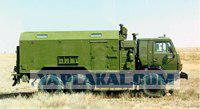
Key Features:
The firing range, km 50-280
Start time rockets, mines 4-16
The interval between starts minutes 1
The number of missiles in the STC / TPM 2/2
CU Type: cassette, high-explosive fragmentation, penetration
Control system: inertial autonomous optical seeker
Mass missile / warhead, kg 3800/480
Rocket engine RDDT
Temperature range, degrees. +50
Lifetime, years 10, including 3 field

Missile system "Iskander" in their tactical and technical characteristics fully compliant Control Regime non-proliferation of missile technology. He is the "weapon of deterrence" in local conflicts and in countries with limited territory - a strategic weapon. The structure of the complex, its management systems, automated command and control and information systems make it possible to respond quickly to new requirements without substantial revision of its combat vehicles and, therefore, guarantee a long life cycle.
PTRC "Iskander" is integrated with different systems of intelligence and control. He is able to obtain information about scheduled to hit a target satellite, reconnaissance aircraft or unmanned aerial vehicle (such as "Reis-D") in the preparation of the information point (PIP). It is calculated for a rocket flight mission and is preparing standard information for missiles. In radio channels, this information is transmitted to the command and staff vehicles battalion commander and the battery, and then - to the launchers. Teams in the missile launch could come from CSV or artillery command posts of senior chiefs.
Accommodation on each SPU and TLV two missiles significantly increases the firepower of the missile battalions, and an interval of one minute between starts missiles at different targets provides high fire performance.
By its efficiency, taking into account the aggregate combat capabilities, operational and tactical rakteny complex "Iskander" is equivalent to a nuclear weapon.
Source
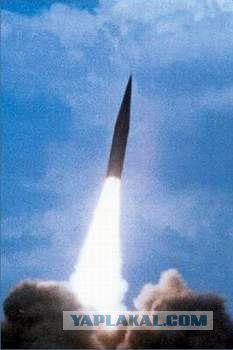
Source:
From Moscow and Minsk almost simultaneously, with a difference of one day, we made a statement that Russia begins deliveries to Belarus newest tactical missile system (PTRC) "Iskander-E", and she begins to rearm an even more perfect "Iskander -M '. Both parties do not hide that the retrofitting to a large extent is the answer to deploying US missile defense (NMD) in Poland and the Czech Republic. So through its Spokesman Andrei Popov is the Belarusian Foreign Ministry made it clear: "Our republic will ensure its security in the new conditions, particularly in terms of placing elements of the US missile defense system in Europe." Especially since, according to him, Minsk sees no objective preconditions and reasons for placement in close proximity to the elements of the system of Belarus. And the chief of the Missile Forces and Artillery (PBA) of the Armed Forces (AF), Colonel-General Vladimir Zaritsky also stressed that the supply of Russian "Iskander" in Belarus can be considered as a variant of an asymmetric response to the deployment in Europe of US missile defense.
Analysts in both countries is still "obsmakovyvayut" the theme of "Iskander" for Belarus. It's no wonder, because the relationship between Minsk and Moscow because of the known problems in the price of gas and oil to Belarus in the past year and a half has cooled considerably. And then such a successful agreement in the military sphere! After almost Belarus was the first country, which will begin delivery of said missiles. Assumptions are also sometimes fantastic (if not tactful to say "crazy") character. For example, one of the notorious military observers agreed to the fact that Russia, delivering "Iskander-E", thus transit via Belarus wants to smuggle complexes to Syria. "MIC" tried, using only open sources, as they say, from different angles to analyze the situation.

High-precision operational-tactical missile complex land forces 9K720 "Iskander" for the secretive preparation and application of effective missile strikes on especially important miniature and area targets in the depth of operational formation of the enemy: fire weapons (missiles, multiple rocket launcher systems, long-range artillery), aircraft and helicopters airfields, command posts and communications nodes, critical civilian infrastructure.
PTRC 9K720 created as a result of the joint work group of research institutes, design bureaus and factories under the leadership of Machine Building Design Bureau (KBM Kolomna), known as a company-maker of missile systems "Point", "Oka". The launcher is designed CDB "Titan" (Volgograd), homing system - the Central Research Institute of Automatics and Hydraulics (Moscow).
Under the conditions of the INF Treaty of 1987 and the non-use of nuclear weapons in the theater to modern tactical systems presented a number of new requirements:
* Use only non-nuclear weapons;
* Ensure precision shooting accuracy;
* Management throughout the flight path;
* Wide range of effective combat equipment;
* Availability of complex automation systems and command and control information management system, including the preparation of standard information systems for correction and final guidance;
* The possibility of interconnecting with the global satellite navigation systems (GNSS - "Glonass», «NAVSTAR»);
* The ability to defeat heavily defended purposes;
* Improving fire performance;
* The ability to effectively overcome the effects of air defense and missile defense;
* The possibility of destruction of moving targets.

To meet the above requirements established export version PTRC 9K720, designated "Iskander-E". "Iskander-E" incorporates the best scientific, technical and design achievements in the field of tactical missiles and jointly implemented technical solutions, high combat effectiveness is an entirely new generation of weapons, superior to their tactical and technical characteristics of existing RC 9K72 "Elbrus", "Tochka-U», «Lance», «ATASMS», «Pluton», and others.
The main features of the Republic of Kazakhstan 9K720 «Iskander»:
* High-precision and effective engagement of various types of targets;
* The possibility of secretive preparation, alert and effective missile strikes;
* Automatic calculation and entry flight mission rocket launcher means;
* High probability of combat mission in the face of strong enemy opposition;
* High probability of trouble-free operation of a rocket in preparation for launch and in flight;
* High tactical maneuverability thanks to all-terrain military vehicles, mounted on four-wheel drive chassis,
* Strategic mobility due to transportability of machines all modes of transport, including transport aircraft;
* Automation of combat control missile units,
* Prompt processing and bring intelligence to the appropriate management levels;
* Long life and ease of use.

"Iskander-E" in their tactical and technical characteristics fully in line with the position of Control Regime non-proliferation of missile technology. This "weapon of deterrence" in local conflicts and in countries with limited living space - a strategic weapon. The structure of the complex, its management systems, automated command and control and information systems make it possible to respond quickly to new requirements without substantial revision of its combat vehicles and, therefore, guarantee a long life cycle.
For the Russian army developed version of the missile complex "Iskander" with extended range (400km), but also equipped with cruise missiles "ground-ground" of the "Caliber" (SKB "Innovator" Bratislava). The complex, designated "Iskander-M", successfully tested on May 29, 2007. on at Kapustin Yar.
In the west complex has received the designation SS-26.

The complex includes:
* 9M723 missile;
* Self-propelled launcher 9P78 (SDA);
* Transport and loading vehicle 9T250 (TPM);
* Command-staff vehicle 9S552 (CSV);
* Movable item of information 9S920 preparation (PPI);
* Vehicle regulation and maintenance (MRTO);
* Life-support machine;
* Sets the arsenal and the training equipment.
Missile 9M723 - solid-fuel, single stage with a non-detachable warhead in flight. The missile is controlled throughout the flight path with the help of aerodynamic and gasdynamic rudders. The flight path is not 9M723 ballistic and controlled. The rocket plane is constantly changing trajectory. Particularly active in the area, she maneuvered her acceleration and approach to the goal - with an overload of 20 to 30g. In order to intercept a missile 9M723, antimissile should move along the path with the overload of two to three times higher, and it's almost impossible. Most of the trajectory the rocket, made by technology 'Stealth' and having a small reflecting surface is at an altitude of 50 km, which also significantly reduces the likelihood of its defeat the enemy. The effect of 'invisibility' is achieved through the combination of design features and handling of missiles with special coatings.
Directly on the target missile is displayed c using an inertial control system and then captured autonomous correlation-extreme optical homing head (see photo). The operating principle of homing OTP 9M723 is that the optical apparatus forms an image of the terrain in the target area, which is compared to an onboard computer with an introduction to the preparation of the rocket for launch benchmark. The optical head has a high resistance to existing electronic warfare and allows the successful launch even on moonless nights, when there is no more natural lighting purpose, striking a moving target with an accuracy of plus or minus two meters. A similar problem, except for "Iskander" can not solve none of the tactical system in the world. In addition, the optical system does not require signals from space navigation system, which is in crisis cases, it may be turned off or disabled by RFI. Integration of inertial control with satellite navigation and optical seeker to create a missile strikes a given target in almost any conceivable circumstances. Seeker can also be used in the ballistic and cruise missiles of various classes and types.
The missile can be fitted with different warheads (total of 10 types), incl .:
* Cassette warhead with fragmentation submunitions undermine the non-contact;
* Cassette warheads with cumulative fragmentation submunitions;
* Cassette warhead submunitions with self;
* Cassette warhead volume-detonating action;
* High-explosive fragmentation warhead (OFBCH);
* High-explosive incendiary warhead;
* Penetrating warhead (COEP).

Cassette warhead ensure disclosure at the height 0.9-1.4km with further separation and stabilization of combat elements. Submunitions equipped with radio sensors, undermining the combat elements are at the height of 6-10m above the target.
Thanks to the implementation and management of terminal guidance, control the entire flight path, a wide range of powerful warhead and providing aggregation SU board with various systems of correction and homing, and the high probability of a combat mission in the face of strong opposition from the enemy target types are affected only 1 start 2 missile Kazakhstan "Iskander-E", that the performance is equivalent to the use of a nuclear weapon.

Fully autonomous SPU placed on wheeled chassis 8x8 terrain (MZKT-7930) and is designed for storage and transportation of missiles, launch preparation and start shooting within a sector of ± 90 ° relative to the direction of arrival SPU. SPU provides: automatic definition of their coordinates communication with all levels of government, alert and preparing to launch a rocket with a finding in a horizontal position, and a single salvo missile launching, storage and testing of missiles. The most important feature of the launcher has been placed on it are not the same (as the "point" and "Oke"), and two rockets. Time Spent launcher on the launch pad and a minimum of 20 minutes, with an interval between starts of the 1st and 2nd launch no more than one minute. For launches do not require specially trained in Engineering and Surveying against starting positions, which may lead to the disclosure of their opponent. Launches can be made from so-called "readiness to march," ie, launcher calls in any area (except for the marshy terrain and shifting sands) and its calculation in an automated cycle, without leaving the cab is preparing and launching missiles. Then the launcher moves to point charge and after loading the missile is ready to spray again missile attack from any starting position.

TPM is also placed on the chassis MZKT-7930, and is equipped with a jib crane. Full combat weight - 40000kg, the calculation of TRV - 2 persons.

Automated control system built on a unified database for all levels of management command and staff vehicles, made on chassis of KAMAZ family. Setting up a certain level of control (brigade, division, starting battery) is carried out by software during operation. To ensure the exchange of information in the launcher available equipment combat control and communications. Information exchange can take place both in open and closed channels of communication.
"Iskander-M" is integrated with different systems of intelligence and control. Information about object destruction is transmitted from the satellite, reconnaissance aircraft or unmanned aerial vehicle (such as "Reis-D") in the preparation of the information point (PIP). It is calculated for a rocket flight mission and is preparing standard information for missiles with OGSN, then this information by radio broadcast on command and staff vehicles (CSV) battalion commander and the battery, and then - on the launcher. Teams in the missile launch may be generated in CSV, and come from the control posts of senior artillery commanders.

Machine regulation and maintenance (MRTO) posted wheeled vehicle family "Kamaz" and is designed for routine test on-board equipment of missiles deployed on the TLV (as well as in containers), test instruments, members of the group SPTA elements of the complex and maintenance missile forces calculation MRTO.
Machine weight is 13, 5 m, the deployment does not exceed 20 min., While the automated cycle routine test missiles on-board equipment - 18 min., The calculation - 2 persons.

Item preparation of information (PPI) is designed to determine the coordinates of the target, prepare the necessary information and bring it to self-propelled launcher.
PPI has two workstations, provides the coordinates of the target and bring them to the SDA during not more than 2 and 1 minute, respectively. Able to conduct continuous combat duty for 16 hours.

Key Features:
The firing range, km 50-280
Start time rockets, mines 4-16
The interval between starts minutes 1
The number of missiles in the STC / TPM 2/2
CU Type: cassette, high-explosive fragmentation, penetration
Control system: inertial autonomous optical seeker
Mass missile / warhead, kg 3800/480
Rocket engine RDDT
Temperature range, degrees. +50
Lifetime, years 10, including 3 field

Missile system "Iskander" in their tactical and technical characteristics fully compliant Control Regime non-proliferation of missile technology. He is the "weapon of deterrence" in local conflicts and in countries with limited territory - a strategic weapon. The structure of the complex, its management systems, automated command and control and information systems make it possible to respond quickly to new requirements without substantial revision of its combat vehicles and, therefore, guarantee a long life cycle.
PTRC "Iskander" is integrated with different systems of intelligence and control. He is able to obtain information about scheduled to hit a target satellite, reconnaissance aircraft or unmanned aerial vehicle (such as "Reis-D") in the preparation of the information point (PIP). It is calculated for a rocket flight mission and is preparing standard information for missiles. In radio channels, this information is transmitted to the command and staff vehicles battalion commander and the battery, and then - to the launchers. Teams in the missile launch could come from CSV or artillery command posts of senior chiefs.
Accommodation on each SPU and TLV two missiles significantly increases the firepower of the missile battalions, and an interval of one minute between starts missiles at different targets provides high fire performance.
By its efficiency, taking into account the aggregate combat capabilities, operational and tactical rakteny complex "Iskander" is equivalent to a nuclear weapon.
Source

Source:
Tags
See also
Evolution of Putin: 28 magazine covers with the Russian president.
100 best photos of April 2010
Why did Russia do not believe?
Israel's war against Georgia and Russia
123 facts about Belarus through the eyes of Russians
Invasion of Ukraine: the latest developments in the Crimea and the south-east
Two related news
Opponent in Sweden, our technology is the best
Nuclear top
Eurotrip on a motorcycle or the seven seas

















